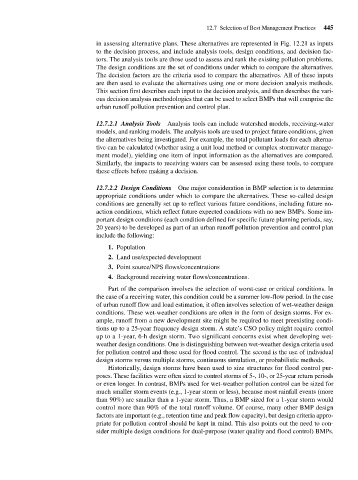Page 487 - Fair, Geyer, and Okun's Water and wastewater engineering : water supply and wastewater removal
P. 487
JWCL344_ch12_398-456.qxd 8/4/10 9:37 PM Page 445
12.7 Selection of Best Management Practices 445
in assessing alternative plans. These alternatives are represented in Fig. 12.21 as inputs
to the decision process, and include analysis tools, design conditions, and decision fac-
tors. The analysis tools are those used to assess and rank the existing pollution problems.
The design conditions are the set of conditions under which to compare the alternatives.
The decision factors are the criteria used to compare the alternatives. All of these inputs
are then used to evaluate the alternatives using one or more decision analysis methods.
This section first describes each input to the decision analysis, and then describes the vari-
ous decision analysis methodologies that can be used to select BMPs that will comprise the
urban runoff pollution prevention and control plan.
12.7.2.1 Analysis Tools Analysis tools can include watershed models, receiving-water
models, and ranking models. The analysis tools are used to project future conditions, given
the alternatives being investigated. For example, the total pollutant loads for each alterna-
tive can be calculated (whether using a unit load method or complex stormwater manage-
ment model), yielding one item of input information as the alternatives are compared.
Similarly, the impacts to receiving waters can be assessed using these tools, to compare
these effects before making a decision.
12.7.2.2 Design Conditions One major consideration in BMP selection is to determine
appropriate conditions under which to compare the alternatives. These so-called design
conditions are generally set up to reflect various future conditions, including future no-
action conditions, which reflect future expected conditions with no new BMPs. Some im-
portant design conditions (each condition defined for specific future planning periods, say,
20 years) to be developed as part of an urban runoff pollution prevention and control plan
include the following:
1. Population
2. Land use/expected development
3. Point source/NPS flows/concentrations
4. Background receiving water flows/concentrations.
Part of the comparison involves the selection of worst-case or critical conditions. In
the case of a receiving water, this condition could be a summer low-flow period. In the case
of urban runoff flow and load estimation, it often involves selection of wet-weather design
conditions. These wet-weather conditions are often in the form of design storms. For ex-
ample, runoff from a new development site might be required to meet preexisting condi-
tions up to a 25-year frequency design storm. A state’s CSO policy might require control
up to a 1-year, 6-h design storm. Two significant concerns exist when developing wet-
weather design conditions. One is distinguishing between wet-weather design criteria used
for pollution control and those used for flood control. The second is the use of individual
design storms versus multiple storms, continuous simulation, or probabilistic methods.
Historically, design storms have been used to size structures for flood control pur-
poses. These facilities were often sized to control storms of 5-, 10-, or 25-year return periods
or even longer. In contrast, BMPs used for wet-weather pollution control can be sized for
much smaller storm events (e.g., 1-year storm or less), because most rainfall events (more
than 90%) are smaller than a 1-year storm. Thus, a BMP sized for a 1-year storm would
control more than 90% of the total runoff volume. Of course, many other BMP design
factors are important (e.g., retention time and peak flow capacity), but design criteria appro-
priate for pollution control should be kept in mind. This also points out the need to con-
sider multiple design conditions for dual-purpose (water quality and flood control) BMPs.

